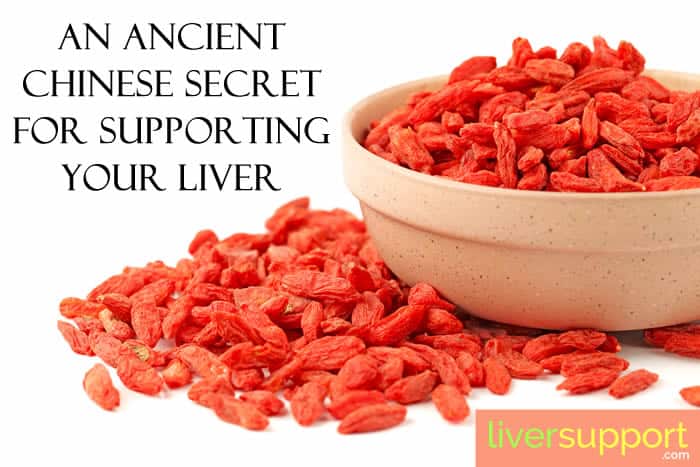
Previous
Want to Improve Your Liver Health? Eat an Orange.

Next
How a Healthy Liver Enhances Your Life
An Ancient Chinese Secret for Supporting Your Liver
Move over raisins – wolfberries are really something to howl about when it comes to liver healthy snacking.
Typically found in dried form in the U.S., wolfberry deserves to be on your healthy-food- for-your-liver radar. Commonly referred to as goji berry or lycium berry, the fruit of Lycium chinensis has been used for centuries both as food and medicine by the Chinese. While most berries contain antioxidants and are good for you, wolfberries have a special characteristic: they also support and protect your liver. As such, those concerned with their liver’s well-being would be wise to snatch these tasty little treats up whenever they are available.
Wolfberry’s Origins
A rangy shrub native to China, goji berry has been used in traditional Chinese medicine (TCM) for more than 2,000 years. Known by TCM practitioners as gou qi zi, its use was first recorded around 200 BCE in Shen Nong Ben Cao Jing, an ancient book detailing the medicinal and agricultural knowledge of the mythical Chinese emperor Shen Nong. Regarded as the oldest book on Chinese herbs, the Shen Nong Ben Cao Jing records 365 traditional herbs that are classified into three grades – top, middle and low. Goji berry is one of the 120 herbs belonging to the top grade, which means it has remarkable health benefits and is harmless to humans.
Long-term use of wolfberry was advised in the Shen Nong Ben Cao Jing for:
- strengthening your body
- keeping fit
- prolonging life
- easing life through all the seasons
Wolfberry in TCM
Another classic TCM treatise, the Compendium of Materia Medica, is a collection of books by Li Shi-Zhen from the sixteenth century that is used as a primary herbal medicine reference text in many modern TCM graduate training programs. The Materia Medica is considered the first pharmacopoeia in the world and the most important one ever written on TCM. Inside, the morphological identification, health benefits, indications, and relevant prescriptions of goji berry are detailed. According to TCM theory and practice, wolfberry influences both the liver and kidney channels and nourishes these organ systems.
Today, acupuncturists and TCM practitioners commonly use wolfberry for patients with a liver disharmony who exhibit indications of a liver fluid deficiency and/or liver blood deficiency. These deficient patterns are common in individuals who are battling a chronic liver condition where symptoms of dryness and fatigue are prominent. In addition to being a key ingredient in many types of tonification formulas, wolfberry is also suggested as a food for supporting vitality.
Wolfberry Nutrients
These little orange-red berries are nutritional powerhouses. Because it is a delicate fruit, goji berry does not withstand shipping well. Thus, it is typically found in dried form or as a juice.
5 of Wolfberry’s Nutritional Details:
- A ¼ cup of dried wolfberries has 4 grams of protein.
- A ¼ cup of dried wolfberries has 3 grams of fiber.
- A ¼ cup of dried wolfberries has 140% of the daily Vitamin A requirement.
- A ¼ cup of dried wolfberries has 20% of the daily Vitamin C requirement.
- Wolfberry also contains phenols, polysaccharides, beta-carotene, lycopene, riboflavin, thiamine, zeaxanthin, lutein, selenium, and nicotinic acid.
Wolfberry’s Liver Claims
In addition to being used for anti-aging, heart health, improving vision, boosting the immune system and cancer prevention, wolfberry has a specific benefit for your liver. As published in the July 2010 edition of Journal of Ethnopharmacology, researchers discovered that wolfberry juice helps protect your liver from oxidation. In this tissue culture study, liver cells exposed to toxins and then treated with wolfberry extract showed fewer free radicals – molecules that cause cell damage.
Research on a related species from where wolfberries can derive, Lycium barbarum, was the focus of a 2016 Italian study published in BioMed Research International. According to the research, the effect of Lycium barbarum berries cultivated in Umbria (Italy) on human hepatocellular carcinoma (liver cancer) cells was significant. The results provided evidence that Umbrian Lycium barbarum berries could play a protective role against liver cancer.
Eating Wolfberry
Although wolfberry extract or herbal formulations require a knowledgeable practitioner’s oversight, consuming the dried fruit can be done autonomously. For general health and wellness, New York University’s Langone Medical Center recommends including 3 to 4 tablespoons of wolfberry in your daily diet.
Four suggestions on its use are similar to eating raisins:
- Add them to trail mix
- Sprinkle them in hot or cold cereal
- Use them for a sweet bite in salads
- Stir into muffin mix or bread batter
The health benefits of wolfberry are well known in Chinese culture and, as such, it is not surprising for Chinese people to keep them stocked in their pantry. However, those of any race or culture can enjoy wolfberries. Because they are a potent mixture of antioxidants that protects liver cells, consuming these sweet, brightly colored, dried berries is an ancient Chinese secret for supporting your liver.
http://healthyeating.sfgate.com/chinese-wolfberry-benefits-doses-8671.html, Chinese Wolfberry Benefits & Doses, Retrieved February 11, 2018, Hearst Communications, Inc., 2018.
https://www.livestrong.com/article/441412-wolfberry-benefits-side-effects/, Wolfberry Benefits and Side Effects, Karen McCarthy, Retrieved February 11, 2018, livestrong.com, 2018.
https://www.ncbi.nlm.nih.gov/books/NBK92756/, Chapter 14 - Biomolecular and Clinical Aspects of Chinese Wolfberry, P Bucheli, et al, Retrieved February 11, 2018, “Herbal Medicine: Biomolecular and Clinical Aspects, 2nd edition”, CRC/Press Taylor & Francis, 2011.
https://www.ncbi.nlm.nih.gov/pubmed/27965980, In Vitro Protective Effects of Lycium barbarum Berries Cultivated in Umbria (Italy) on Human Hepatocellular Carcinoma Cells, Ceccarini MR, et al, Retrieved February 11, 2018, BioMed Research International, November 2016.






